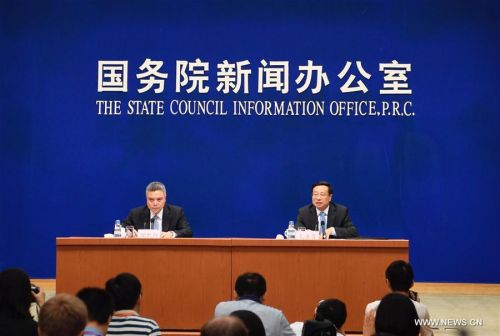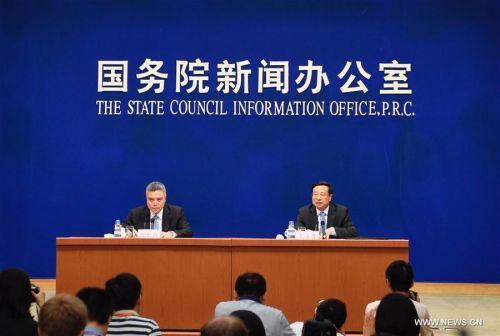
Mao Shengyong (R), spokesperson of the National Bureau of Statistics, speaks at a press conference held by the State Council Information Office in Beijing, capital of China, Aug. 14, 2017. Growth of China's factory output dropped a notch in July, but industrial upgrades continued as the country strove to move up the industrial value chain, data showed Monday. (Xinhua/Jin Liangkuai)
BEIJING, Aug. 14 (Xinhua) -- Fresh data added to evidence that China's economy was heading for a slower but steadier growth as the country endeavored to sustain sound development while defusing risks.
After a strong rebound in the first two quarters, data released Monday by the National Bureau of Statistics (NBS) showed growth of factory output, investment and consumption all slowed a notch from the previous month.
Value-added industrial output grew 6.4 percent year on year in July, down from the 7.6-percent increase for June but up from the 6-percent rise for the same month of last year.
Fixed-asset investment growth slowed to 8.3 percent in the first seven months from 8.6 percent in H1, while retail sales rose 10.4 percent in July from a year earlier, cooling from June's 11 percent pace.
Growth of private investment, which accounts for 60.7 percent of total investment, slowed to 6.9 percent for January-July from 7.2 percent in the first half of the year.
Zhang Liqun with the Development Research Center of the State Council, said the indicators' moderation was a short-term fluctuation affected by adverse weather, and would not change the trend of a stable economic growth.
China's economic performance has been generally stable with better momentum, which would stay unchanged during the rest of the year, NBS spokesperson Mao Shengyong told a press conference.
The government would focus more on improving the quality and efficiency of economic growth. "China should not only pursue a larger economic size, but also strive to build muscles to make the economy more robust," Mao said.
China targets an annual economic growth of around 6.5 percent for 2017, down from the 6.7 percent pace recorded in 2016.
With traditional growth engines losing steam while the old growth pattern leading to issues such as environmental degradation and economic inequality, China is pressing with a new model of economic development that draws strength from consumption, services sector and innovation.
In breakdown, Monday's data showed the country's economic rebalancing and industrial upgrades continued apace, injecting vitality into the economy.
Service sector, which contributed 59.1 percent to economic growth in the first half of the year, continued strong growth. The service sector production index rose 8.3 percent in July, up from 7.8 percent for the same month of 2016.
Industrial output of high-tech industries rose 12.1 percent year on year in July, while that of equipment manufacturing sector climbed 10.7 percent, both exceeding that of the overall output growth.
Despite the July indicators' slowdown, employment remained stable. The urban surveyed unemployment rate stood at 5.1 percent last month, lower than that for July 2016.
Citing downward pressure such as slowing credit growth as China focused on financial stability and deleveraging, a downturn in the real estate sector and slower export growth, Bloomberg chief Asia economist Tom Orlik expected China's GDP growth to slow to 6.5 percent in the fourth quarter from 6.9 percent in the second quarter.
Even slowing by 0.1 or 0.2 percentage point in the second half of the year, China's economic growth rate would be reasonable and normal, and would remain one of the best performers among global major economies, Mao said.
For the longer term, China can maintain medium-high speed growth, as the economy is resilient and has huge potential, while reforms and innovation will yield dividends to support growth, he said.




 A single purchase
A single purchase









